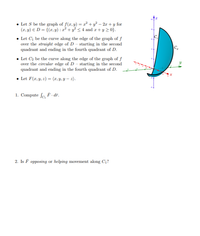
Advanced Engineering Mathematics
10th Edition
ISBN: 9780470458365
Author: Erwin Kreyszig
Publisher: Wiley, John & Sons, Incorporated
expand_more
expand_more
format_list_bulleted
Concept explainers
Question
Let S be the graph of f(x, y) = x2 + y2 - 2x + y for
(x, y) ∈ D = {(x, y) : x2 + y2 ≤ 4 and x + y ≥ 0}.
Let C1 be the curve along the edge of the graph of f
over the straight edge of D – starting in the second
quadrant and ending in the fourth quadrant of D
• Let C2 be the curve along the edge of the graph of f
over the circular edge of D – starting in the second
quadrant and ending in the fourth quadrant of D.
Let F(x, y, z) = ⟨x, y, y z⟩
Compute R:
C1 F¯ · dr¯.

Transcribed Image Text:• Let S be the graph of f(r,y) = r² + y² – 2r + y for
(1, y) E D = {(r, y) : x² + y² < 4 and z+ y 2 0}.
• Let C, be the curve along the edge of the graph of f
over the straight edge of D - starting in the second
quadrant and ending in the fourth quadrant of D.
C
• Let C2 be the curve along the edge of the graph of f
over the circular edge of D - starting in the second
quadrant and ending in the fourth quadrant of D.
• Let F(r,y, 2) = (x, Y, Y – 2).
1. Compute fo F. dr.
2. Is F opposing or helping movement along C1?
Expert Solution
This question has been solved!
Explore an expertly crafted, step-by-step solution for a thorough understanding of key concepts.
Step by stepSolved in 3 steps with 3 images

Knowledge Booster
Learn more about
Need a deep-dive on the concept behind this application? Look no further. Learn more about this topic, advanced-math and related others by exploring similar questions and additional content below.Similar questions
- On a grid (x-y plane), a road is designed have a curve defined by 3 f(x) = x² + 2 for 0 ≤ x ≤. Find the length of the road from x = 0 to x = km.arrow_forwardIf (x+1) replaces x , and (y+2) replaces y , describe the effect on the graph of y=f(x) A) Stays in the same postion B) moves one unit left and two units down C) moves one unit left and two units up D) moves one unit right and two units uparrow_forwardConsider the following R2 →R function: b) Plot the level curves for c = 0, 1, 2 and 3arrow_forward
- Consider the function z = 4x²+4y²-4 z = f(x, y). Find equations for the xy-trace, xz-trace, and yz-trace for the graph of Find equations for the level curves f(x, y) = c for c= -3, 0, 1, 4. Then sketch and luoel these curves in the xy-plane (on the same set of axes).arrow_forwardexplain how they found the tow y values of -5.4 and -0.68arrow_forward
arrow_back_ios
arrow_forward_ios
Recommended textbooks for you
 Advanced Engineering MathematicsAdvanced MathISBN:9780470458365Author:Erwin KreyszigPublisher:Wiley, John & Sons, Incorporated
Advanced Engineering MathematicsAdvanced MathISBN:9780470458365Author:Erwin KreyszigPublisher:Wiley, John & Sons, Incorporated Numerical Methods for EngineersAdvanced MathISBN:9780073397924Author:Steven C. Chapra Dr., Raymond P. CanalePublisher:McGraw-Hill Education
Numerical Methods for EngineersAdvanced MathISBN:9780073397924Author:Steven C. Chapra Dr., Raymond P. CanalePublisher:McGraw-Hill Education Introductory Mathematics for Engineering Applicat...Advanced MathISBN:9781118141809Author:Nathan KlingbeilPublisher:WILEY
Introductory Mathematics for Engineering Applicat...Advanced MathISBN:9781118141809Author:Nathan KlingbeilPublisher:WILEY Mathematics For Machine TechnologyAdvanced MathISBN:9781337798310Author:Peterson, John.Publisher:Cengage Learning,
Mathematics For Machine TechnologyAdvanced MathISBN:9781337798310Author:Peterson, John.Publisher:Cengage Learning,


Advanced Engineering Mathematics
Advanced Math
ISBN:9780470458365
Author:Erwin Kreyszig
Publisher:Wiley, John & Sons, Incorporated

Numerical Methods for Engineers
Advanced Math
ISBN:9780073397924
Author:Steven C. Chapra Dr., Raymond P. Canale
Publisher:McGraw-Hill Education

Introductory Mathematics for Engineering Applicat...
Advanced Math
ISBN:9781118141809
Author:Nathan Klingbeil
Publisher:WILEY

Mathematics For Machine Technology
Advanced Math
ISBN:9781337798310
Author:Peterson, John.
Publisher:Cengage Learning,

